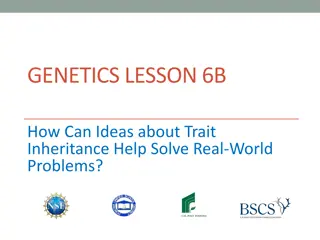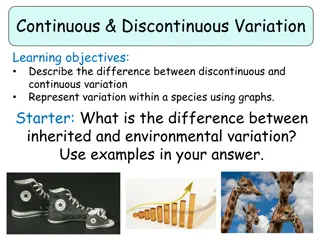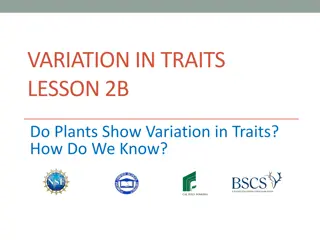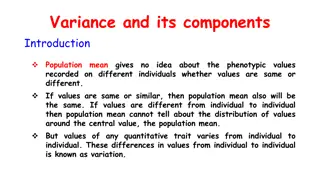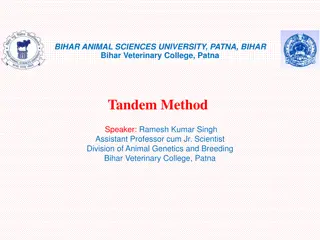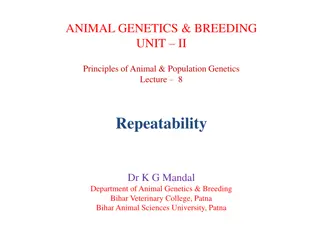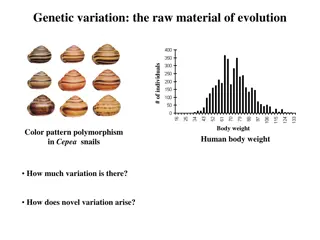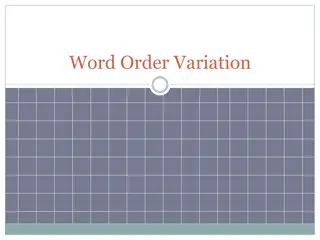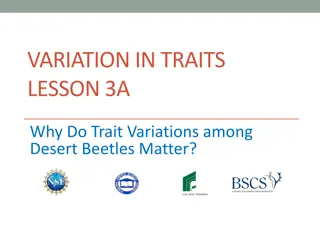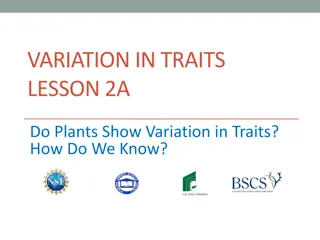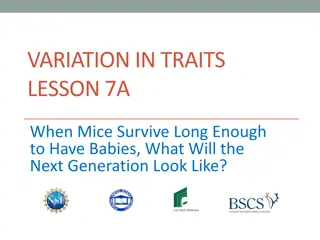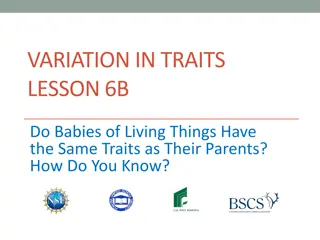Understanding Sickle Cell Trait in Intercollegiate Athletics
Sickle cell trait is a hereditary condition affecting red blood cells' shape and oxygen-carrying capacity. Individuals with this trait can experience complications during intense exercise, leading to health risks in athletics. This article explores the impact of sickle cell trait on athletes, the re
0 views • 15 slides
Understanding Trait Inheritance for Real-World Problem Solving
Discover how the study of trait inheritance in genetics helps solve real-world problems through examples like the Wilson family case study. Explore key concepts such as chromosomes, genes, alleles, dominant and recessive traits, and the Hansen family pedigree to grasp the significance of genetic inh
0 views • 13 slides
Understanding Genetics: The Key Concepts and Applications
Genetics is a vital field of biology focusing on genes, heredity, and genetic variation. This branch of science has deep roots in human history, influencing agriculture and shaping biological disciplines like evolution and developmental biology. Key subdisciplines include transmission genetics, mole
0 views • 26 slides
BMC's QI Hub: Your Quality Improvement Resource
BMC's QI Hub offers professional coaching, educational tools, support, mentorship, and more for quality improvement. Learn about run charts, understanding variation, tracking data over time, and distinguishing between common cause and special cause variation. Discover how run charts help assess inte
0 views • 38 slides
Understanding Continuous and Discontinuous Variation in Species
Explore the concepts of continuous and discontinuous variation within species, distinguishing between inherited and environmental factors. Engage in practical activities to represent variation graphically and categorize characteristics based on their variability. Promote interactive learning through
0 views • 15 slides
Exploring Plant Traits: Do Plants Exhibit Variation in Traits?
Discover in this lesson whether plants display variations in traits through the measurement of plant lengths. Students analyze data tables of carrots and leaves to observe trait variations and discuss patterns found in bar graphs and data tables. The focus is on understanding how to identify and int
0 views • 11 slides
Analysis of Trip Rates Variation in TRICS Consortium by Owen Edwards
An analysis by TRICS Consortium, led by Owen Edwards, delved into trip rates variation, revealing minor and inconsistent variations in factors influencing trip rates, such as location type, local population, and public transport levels. The research focused on major location types and popular land u
0 views • 43 slides
Understanding Genetic Markers in Molecular Mapping
Genetic markers play a crucial role in gene mapping within molecular biotechnology. They are fragments of DNA associated with specific genomic locations, aiding in identifying DNA sequences and analyzing genetic variation. Various types of genetic markers such as RFLP, SSR, and SNP offer insights in
1 views • 26 slides
Enhancing Science Learning Through Student Thinking Strategies
Explore Day 3 of the RESPeCT Summer Institute focusing on STL strategies, lesson analysis, traits variation, and student engagement in scientific thinking. Uncover trends in reflections, student questions, and activities that advance science learning without rote memorization. Delve into the purpose
0 views • 67 slides
Residential Trip Rate Variation Analysis by Ian Coles, Project Manager at TRICS Consortium Limited
Residential TRICS analyzes trip rate variation within different sub-categories based on ownership and housing types. The analysis includes sub-categories like Houses Privately Owned, Flats for Rent, Mixed Private Housing, and more. The study focuses on surveys conducted between 2000 and 2021, catego
0 views • 22 slides
Understanding Somaclonal Variation in Plants
Somaclonal variation refers to genetic variations in plants produced through tissue culture, leading to changes in chromosome structure, growth rate, and fertility. This variation can be caused by physiological, biochemical, and genetic factors, and is detectable through morphological and cytologica
0 views • 21 slides
Genomic Evaluation of a 2-Month-Old Female with Tetralogy of Fallot
This case involves a 2-month-old female with Tetralogy of Fallot, carrying a genetic variation in the 19p13.11 region. The evaluation process includes assessing genes, known dosage sensitivity, gene count, and detailed analysis of the duplication found in the DGV Gold Standard Dataset. The frequency
0 views • 17 slides
Quality Control Tests for Tablet Production
Quality control tests play a crucial role in ensuring the safety and efficacy of tablet products. This article discusses various parameters like general appearance, size, shape, unique identification markings, organoleptic properties, hardness, friability, weight variation, and content uniformity th
1 views • 11 slides
Principles of Animal Breeding Theory and Methods of Selection
Animal breeding involves selecting for desirable traits to improve the overall merit of animals. Methods such as tandem selection and multi-trait selection are used to enhance genetic progress. Economic value, genetic significance, and selection criteria play important roles in the breeding process.
1 views • 16 slides
Understanding Variance and Its Components in Population Studies
Variance and its components play a crucial role in analyzing the distribution of quantitative traits in populations. By measuring the degree of variation through statistical methods like Measures of Dispersion, researchers can gain insights into the scatterness of values around the mean. Partitionin
1 views • 22 slides
Essential Heroic Trait Comparison: Atticus vs. Another Hero
A comparative analysis through an argumentative synthesis essay between Atticus from TKAM and another hero, focusing on the most crucial trait all heroes should possess. The essay addresses opposing claims and highlights the importance of a singular heroic attribute.
0 views • 25 slides
Insights into Evolutionary Adaptation and Genetic Variation
The production order highlights the essential role of genomic variation as fuel for natural selection, driving evolutionary adaptation. The Cambrian Explosion timeframe reveals a rapid increase in evolutionary adaptation, showcasing the appearance of diverse animal phyla over a relatively short peri
5 views • 6 slides
Pharmaceutical Tablet Testing Procedures and Considerations
This informative content delves into weight variation, content uniformity, and disintegration tests conducted in pharmaceutical laboratories. It discusses official testing methods, factors affecting test outcomes, and requirements for ensuring potency uniformity and tablet quality. Content covers we
0 views • 15 slides
Understanding Personality Traits and Assessments
Psychologists utilize traits to describe personality, addressing common misunderstandings about introversion and exploring the strengths and weaknesses of personality inventories. The consistency of personality traits over time and across situations is examined, along with the identification of insi
0 views • 38 slides
Understanding Standard Deviation, Variance, and Z-Scores
Explore the importance of variation in interpreting data distributions, learn how to calculate standard deviation, understand z-scores, and become familiar with Greek letters for mean and standard deviation. Discover the significance of standard deviation in statistical analysis and the difference b
1 views • 18 slides
Understanding Variation in Statistical Studies
Variability is key in statistical studies, shaping the essence of statistical analysis. Students often struggle to grasp the concept of variability, despite being taught statistical methods. The term "variation" takes on different meanings in various statistical contexts, presenting challenges in co
2 views • 54 slides
Regional Trip Rates Variation in TRICS Owen Edwards Consortium
Past research by Owen Edwards Consortium on trip rates variation in TRICS regions led to the initiation of a new research phase to confirm or confront previous findings. The importance of factors like location type, local population, and vehicle ownership in determining regional selection was highli
0 views • 59 slides
Understanding Quantitative Genetics Principles in Animal Breeding
Quantitative genetics focuses on the inheritance of characteristics based on degree rather than kind, compared to qualitative genetics. It involves polygenes controlling quantitative traits, which exhibit continuous variation and can be measured using metric units. Qualitative traits, on the other h
0 views • 22 slides
Functional Measurement Systems Analysis for Curve Data Using Random Effects Models
Measurement Systems Analysis (MSA) is crucial in determining the contribution of measurement variation to overall process variation. When dealing with curve data instead of single points, a Functional MSA approach using random effects models can be applied. This involves estimating mean curves, mode
0 views • 5 slides
Tandem Method in Animal Breeding: Sequential Traits Selection
Tandem method in animal breeding involves selecting useful traits sequentially to improve genetic performance. Breeders focus on one trait until a desired level is achieved before moving on to the next trait. While effective in targeted improvement, the method can lead to loss of previously improved
0 views • 6 slides
Understanding Repeatability in Animal Genetics and Breeding
Repeatability in animal genetics assesses the correlation between repeated measurements of a trait on the same individuals. It partitions phenotypic variance into within-individual and between-individual components, aiding in estimating heritability, resemblance between relatives, and genetic determ
0 views • 18 slides
Understanding Direct Variation in Math
Explore the concept of direct variation in math through an analysis of proportional relationships, constants of proportionality, and graph representation. Practice identifying direct variation and determining the constant of proportionality to interpret the data effectively.
0 views • 20 slides
Long-term Variation of Magnet Alignment in SPring-8 Storage Ring
This study focuses on the long-term monitoring and variation of magnet alignment in the SPring-8 storage ring. It includes detailed information on the main events of magnet alignment, monument surveys, magnet installations, and alignment monitoring techniques used over the years at the facility. The
0 views • 30 slides
Understanding Language Variation and Social Identity
Language and society are intricately connected through accent, dialect, standard English, and non-standard English. The concepts of convergence, divergence, covert prestige, and overt prestige influence how identity is formed. This text delves into regional dialects and accents, highlighting the dif
2 views • 63 slides
Understanding Common Cause Variation in Sampling and Process Monitoring
Common cause variation is inherent to a process and represents background noise that can obscure signals of special cause variation. Sampling plans and rational subgrouping help estimate and manage common cause variation in quantitative data. Estimating common cause involves assessing variation with
2 views • 11 slides
Understanding Meiosis and Genetic Variation in Organisms
Meiosis forms variable gametes in organisms, leading to increased genetic variation through the production of haploid gametes by meiosis I and II. Key concepts include homologous chromosomes, crossing over, independent assortment, and linked genes. Terminology such as homologous pairs and human chro
0 views • 29 slides
Understanding Genetic Variation and Its Role in Evolution
Genetic variation is crucial for evolution, providing the raw material for adaptation and species diversity. Phenotypic variation can arise from differences in genotype, environment, or their interaction. Studying genetic variation through statistical analysis and at the molecular level helps us unr
0 views • 47 slides
Understanding Evolution: Natural Selection and Genetic Variation
Change in genetic makeup over time is evolution. Natural selection, driven by competition for resources, leads to differential survival and reproductive success. Genetic variation, mutation, and adaptation play roles in this process. Environmental changes influence evolutionary rate and direction. H
0 views • 20 slides
Understanding Word Order Variation in Language
Explore the concept of word order variation in language, focusing on themes and rhemes. Learn how the word order can be varied and the reasons behind such variations. Discover methods to achieve variation, including thematization and it-cleft structures. Delve into examples illustrating themed reord
0 views • 7 slides
Importance of Trait Variations in Desert Beetles
Exploring the significance of trait variations among desert beetles, this lesson delves into why variations matter and how they impact survival in the desert environment. Through activities and discussions, students analyze traits, predict beetle survival, and understand the implications of variatio
0 views • 10 slides
Understanding Latency Variation in Modern DRAM Chips
This research delves into the complexities of latency variation in modern DRAM chips, highlighting factors such as imperfect manufacturing processes and high standard latencies chosen to boost yield. The study aims to characterize latency variation, optimize DRAM performance, and develop mechanisms
0 views • 37 slides
Challenges of Syntactic Variation in Biblical Hebrew
Linguistic variation in Biblical Hebrew has sparked a heated debate since 2000, challenging traditional dating methods and assumptions. The Structure Debate delves into syntactic variation and the use of the participle, while considering the differing language in Early Biblical Hebrew (EBH) and Late
0 views • 21 slides
Exploring Plant Traits: Understanding Variation in Characteristics
Delve into the world of plant traits and variation in this interactive lesson. Discover how plants exhibit different traits and explore the concept of variation within species. Engage in investigations, measurements, and discussions to deepen your understanding of plant characteristics. Uncover the
0 views • 12 slides
Understanding Trait Variation: Survival of Mice in Changing Environments
The lesson explores how trait variation, specifically fur color, impacts the survival of mice in their environment. By examining how different fur colors help mice blend in and avoid predators, students learn about the role of natural selection and inheritance in shaping future generations of mice.
0 views • 12 slides
Understanding Trait Variation in Living Things
Explore the concept of trait inheritance in living organisms through interactive activities and engaging visuals. Discover whether babies of living things inherit the same traits as their parents and learn how to observe and compare traits between parents and offspring. Dive into the fascinating wor
0 views • 15 slides

